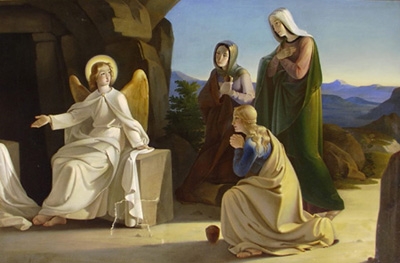Three Marys
Three Marys
The themes of death and life introduced by the Lazarus story continue in this Gospel episode, a passage which John has in common with the synoptic tradition.
According to John, Jesus was put to death the day before Passover and rose the day following it. We are therefore, now in the final week of the new creation, seven days before the exaltation of Christ. John's identification of Bethany as the residence of Lazarus connects this episode with the earlier episode where Jesus had raised his friend from the dead.

It seems evident that the Johannine version of the anointing is the result of a combination of details from the narrative of Luke, Matthew and Mark. However, there is a difference between John and the Synoptics. For Matthew-Mark, Mary's act takes the place of the embalming of Jesus' body which later became impossible because of the hasty burial following the resurrection. John, however, recalls an elaborate embalming of Jesus' body by Nicodemus and Joseph according to the Jewish burial customs. Hence, Mary's embalming is for John spiritual. It is in keeping with his portrayal of Jesus' death as his glorification, the anointing becomes that of the triumphant king on Palm Sunday. This probably explains why the scene of the anointing precedes the triumphant entry into Jerusalem in John, whereas in the Synoptics it occurs later in the week, in close proximity to the crucifixion.
In John the anointing remains connected with Jesus' burial, but with the positive aspect of that burial which is the beginning of true life, in keeping with the paradox of death-and-life brought out in verses 23-25 of the Gospel. Inspired by the insights of Adrienne von Speyr which are set forth in her commentary on the Gospel of John, von Balthasar explains that the union with the sacrifice of the Lord is fundamentally a feminine mystery exemplified in the three Marys: Mary of Bethany who said yes to his death on the cross by anointing his feet; Mary the Mother of Jesus, the contemplative in total abandonment at the foot of the cross, who accepted the loss of Him whom she loved more than anyone else; and Mary Magdalene, the pardoned sinner, who, on the morning of the Resurrection, was told by Christ not to cling to him and to turn herself toward his brothers in order to find Him among them. The three Marys constitute the ecclesial acceptance of the fundamental moments of the Christ-Event: the Incarnation, the Passion and the Resurrection.
The three Marys, dear Brothers, stand for the all-encompassing human attitude in the face of God. The total act of faith comprehends the whole of the divine love-cycle: the love of the Father, the Son and the Spirit. It also comprehends faith, hope and charity: the faith in Incarnation, the hope against hope in the midst of a sea of Passion, and the communion of charity with the Resurrected.
All About Mary includes a variety of content, much of which reflects the expertise, interpretations and opinions of the individual authors and not necessarily of the Marian Library or the University of Dayton. Please share feedback or suggestions with marianlibrary@udayton.edu.
